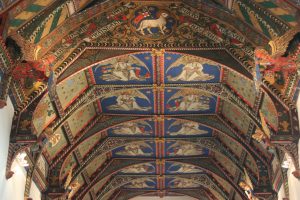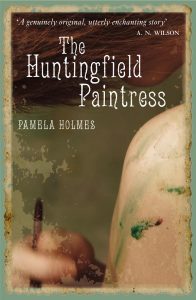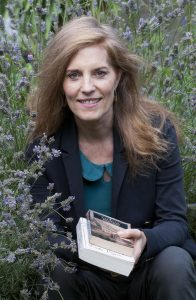The Huntingfield Paintress
 Imagine it. You are a vicar’s wife living in a tiny Suffolk village in the 1850s. You are expected to serve tea to neighbours, to be modestly attired in a boned corset and full skirt and from time to time, to take a basket of provisions to a local family in distress. That’s about it.
Imagine it. You are a vicar’s wife living in a tiny Suffolk village in the 1850s. You are expected to serve tea to neighbours, to be modestly attired in a boned corset and full skirt and from time to time, to take a basket of provisions to a local family in distress. That’s about it.
So what would drive you up a ladder on to scaffolding sixty feet high to stand for six years to create a medieval ceiling in the parish church? It was the question that drove me to find out more about Mildred Holland. For that is what this extraordinary woman did in St Marys’ Church in Huntingfield, Suffolk, England between 1859 – 66. Singlehanded!
To this day you can visit St Mary’s church and slipping one pound into the meter on the stone wall, marvel at the cast of angels that shimmer above your head. In the nave above where the congregation sits, saints and religious scripts and iconography cover the ceiling. Carved winged angels leapt from the hammer beam roof ends and the rafters are thickly patterned and gilded. It is a Gothic extravaganza. Yes, your neck aches ache as you look upwards studying this extraordinary achievement. But you are left with this burning question. Why did Mildred create this glorious work? I had to find out.
 Research revealed fascinating information. In the British Library, I found a parish record entry from 1583 which showed that ‘whiteng’ had been purchased. When Henry V111’s desire for a new Queen meant the Church of England broke away from the authority of the Pope and Rome, monasteries were dissolved. Henry’s daughter the Protestant Elizabeth 1 carried on this work. Churches were required to simplify ornamentation. Some white-washed the walls to blank out religious paintings. Is this what happened at St Mary’s?
Research revealed fascinating information. In the British Library, I found a parish record entry from 1583 which showed that ‘whiteng’ had been purchased. When Henry V111’s desire for a new Queen meant the Church of England broke away from the authority of the Pope and Rome, monasteries were dissolved. Henry’s daughter the Protestant Elizabeth 1 carried on this work. Churches were required to simplify ornamentation. Some white-washed the walls to blank out religious paintings. Is this what happened at St Mary’s?
I also discovered that about a hundred years later, William Dowsing, a Puritan soldier, was commissioned by Oliver Cromwell’s henchmen ‘…for the destruction of monuments of idolatry and superstition” in East Anglia. Some 250 churches in Cambridgeshire and Suffolk and Cambridge University Colleges had their crosses, crucifixes, stained glass and altar rails destroyed by Dowsing or his minions.
An invoice in the parish records signed by William Holland, Mildred’s husband confirmed the vicar paid for the paint and gold leaf that was used in decorating the church – almost £2000! There was also mention of payment to a London-based architect called Edward Blackburne, an authority on medieval decoration who was logged as giving Mildred ‘advice’. Local amateur historian Felicity Griffin, the daughter of a Huntingfield vicar from the 1960s, told me the childless couple had travelled extensively on the Continent for eight years before settling in Huntingfield. Had these travels inspired Mildred?
While none of this explained why Mildred has decided to climb the ladder and create the angel ceiling. there was plenty to spark my imagination. So I put away my journalist’s pen and decided to write ‘my story’ of Mildred’s life.is the result.

Pamela Holmes winner of Jane Austen Short Story Award 2014 organised by Chawton House Library,former home of Jane Austen
I spent two weeks living in Huntingfield, imaging what village life might have been like for Mildred when she arrived in Huntingfield in 1848. I took the winding path she would have followed through the woods from the Rectory to the village as well as visiting local churches such as Blythburgh and Southwold where there are ‘angel’ ceilings. It was a limited life for a vicar’s wife in those times. Mildred may have been isolated, lonely, even bored. How different life from eight years on a Grand Tour of Europe visiting museums and markets, ruins and restaurants from Paris to Constantinople, Milan to Morocco.
I also explored ideas current in the mid-Victorian times. Changes in scientific understanding, the impact of industrialisation on village life, public health and sanitation, attitudes to illegitimacy, even the role of women. For Mildred to have painted the ceiling would have scandalised many so she must have had a powerful and persuasive hold on her husband. People would have questioned whether William had lost his authority over her; what was he thinking to let his wife undertake this dangerous and unconventional task? This marvellous mixture of obsession and opportunity came to life in fiction.
The Huntingfield Paintress is the result. (Urbane Publications) Published May 2016. https://urbanepublications.com/books/the-huntingfield-paintress/
Website: www.pamela-holmes.com
Twitter @Pammieholmes
—
Pamela Holmes was born in Charleston, South Carolina, USA. At the age of eight, she moved with her parents to England and was sent to a strict boarding school. After living on a commune, where she developed a love of milking cows and laying hedges, she studied nursing at London University. She worked as a health journalist and TV reporter. She now works and volunteers to improve the lives of older people including those with dementia, and she sings in a rock band. The Huntingfield Paintress is her first novel. Pamela is the mother of two boys and lives in London with her husband.
Category: On Writing






























